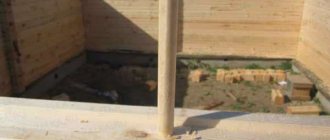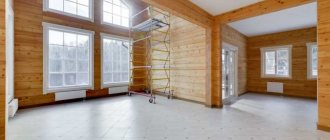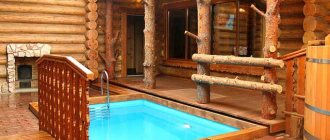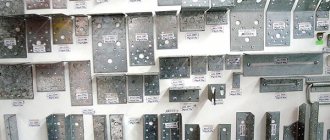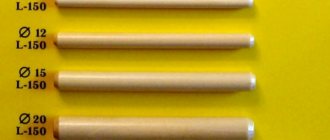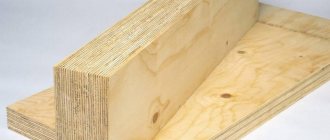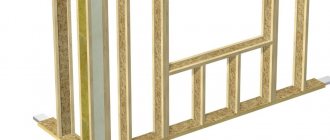In construction terminology, dowels mean rounded rods or bars designed for fastening building parts by installing them in specially prepared holes. The main purpose of dowel connections is to counteract shear forces due to the elasticity of the dowel body.
A wooden dowel for timber is called a dowel or a wooden nail; dowel (dowel) connections are used in the construction of log houses for residential buildings, bathhouses and outbuildings, and are used in the installation of various wooden structures. The technology has a long history; similar fastenings were discovered in buildings of the 16th century on the territory of modern Austria and during excavations in Veliky Novgorod.
Advantages and disadvantages of dowel joints
The advantages of using wooden dowel connections have been tested for centuries, these include:
- Dowels for timber are resistant to deformation, retain elasticity for a long time, and withstand significant bending loads;
- Fastenings counteract the negative consequences of shrinkage, eliminate the causes of the formation of cracks, crevices and gaps between the crowns;
- The timber and dowels react equally to ambient humidity and climate changes, which avoids wall deformation;
- The use of wooden fasteners allows you to build a house without the use of construction equipment and special tools.
The disadvantages include: additional labor costs due to the need to drill installation holes; when selecting materials and carrying out work, certain rules must be followed.
Briefly about the main thing
Self-tapping screws for concrete are universal. With their help, you can attach interior items, household appliances, communications, finishing materials to the concrete surface both outside and inside. Externally, they have the shape of a screw and differ in a number of parameters:
- Material.
- Type of protective coating.
- The shape of the head part.
- Type of thread.
When choosing for specific application conditions, it is necessary to correctly calculate the load, take into account corrosion factors, as well as how the fasteners will be combined with the finishing design and what its final cost will be. During installation, a number of rules must be observed, including safety regulations.
Types of wooden dowels
Dowel cross-sectional shapes
Dowels for timber can have a round, square or rectangular cross-section. It is difficult to cut a square-shaped seat in the body of the beam; for this reason, at home, fasteners of any shape are installed in round holes; the diameter depends on the size of the dowel and should ensure installation “in tension.” Each type of fastening has its own advantages and disadvantages:
- Round dowels (cylindrical) provide maximum area of contact with the walls of the mounting holes, are able to withstand significant loads, and are used to strengthen external walls and corners of the log house. Installing such fasteners “in tension” requires considerable effort. Dowels for round-shaped timber are difficult to make at home; for this you need to have a lathe;
- Dowels for square beams are used in the construction of light buildings and when laying internal partitions. When installed “under tension”, the entire load falls on the sharp edges, which evenly crush and increase the contact area; it is much easier to hammer in such a dowel. You can make a square-shaped mount from cutting a board with your own hands using available tools;
- A flat dowel of rectangular cross-section is a lightweight version of a square dowel, used when installing door and window openings, assembling light and decorative structures.
According to GOST R 56711-2015B, cylindrical dowels are the main fastening element for holding and splicing solid and laminated lumber.
Master's note: to date there is no consensus on the question of which dowels are best to use when laying a log house; some craftsmen prefer dowels with a square cross-section. This fastening ensures freer movement of the timber relative to the dowel ribs and prevents the development of negative processes during shrinkage.
Material requirements
Dowel connections are subject to significant shear, bending and torsion loads. For this reason, round dowels are made of durable wood - this can be oak, larch and birch. For blanks, choose high-grade wood of natural moisture, without knots, with smooth and undamaged fibers. The surface of the finished fasteners is polished using abrasive.
When choosing a material, the following recommendations must be taken into account:
- For beams made of pine or spruce, it is better to use birch dowels;
- When building from larch timber, the fastenings can be made of the same material;
- For laminated veneer lumber and LVL timber, chamber-dried oak is used.
Dowels for square and flat beams can be made from specially selected high-quality lumber used in construction.
Pin sizes and hole diameters
Recommendations for choosing the size of dowel connections are set out in regulatory documents on construction design (SNiP), including: the cross-sectional diameter of round dowels should be no more than 1/6 of the width of the beam, the length should be 1.5 times the height of the beam. The diameter of the landing holes is made 0.5-1.0 mm less than the diameter of the dowel.
It is easy to calculate that when building from 180x180 timber, it is necessary to use dowels with a diameter of 30 mm, a length of more than 270 mm, and the diameter of the holes for installing fasteners is 31 mm. Specialized stores offer dowels in the following sizes: cylindrical with a diameter from 15 to 30 mm, square with a side from 20 to 25 mm, length of blanks - up to 1100 mm.
Device, purpose
A dowel is essentially a screw for concrete. It is made of high-strength steel alloy with subsequent application of an anti-corrosion coating. It can appear white or silver, or yellow or black. At the same time, the difference between the color modifications of the surface in terms of resistance to rust is insignificant. The head of such a screw is often made in the shape of a countersunk cone with a flat base.
They can be supplemented with notches for better retention in the material. On the outside of the base there is a recess in the shape of a star or a cross for inserting a screwdriver bit or screwdriver. The threaded part is made asymmetrical, and is also equipped with special protruding segments along its entire length.
This allows you to strengthen the adhesion of the dowel to the mass of material when screwing. Along with the increased step frequency, this makes it possible to use the fastener both in standard concrete and in modified concrete with reduced density, and for better fixation of the material of the object being fastened.
Fastening a wooden block to a dowel in concrete Source ytimg.com
Note! Initially, the dowel is intended for fastening various objects to concrete. However, the specifics of the device make it possible to use it also for any type of brick. This is due to the peculiarity of the threaded part, in particular, the unevenness of its distribution.
How to make a dowel with your own hands
DIY Nagel
It is advisable to buy a complete set of dowels for building a house; if a few pieces are not enough, you can make dowels yourself. If your household does not have a lathe, you can use a shovel handle. The diameter of the handle is 39-40 mm - this is a lot for a dowel; the excess must be removed with an ax and a plane. A chamfer is removed from the seating edge to form a cone 7-10 mm high, and the surface is cleaned of unevenness using sandpaper. Rectangular dowels for timber are cut from scrap boards using a circular saw or jigsaw, on the seating side the edges of the ribs are cut at an angle of 45-60 degrees, the surface is subjected to finishing (grinding).
Material requirements
Before purchasing dowels, you should decide what material they should be made of . So, if you use them to install structures made of pine or spruce, then preference should be given to birch models. If you plan to use dowels for structures made of larch, then you can purchase parts from the same material.
For laminated veneer lumber, the best option would be samples made from chamber-dried oak base.
Fastening technology
Diagram of the dowel connection device
To install the dowel, you will need to perform a number of operations in the following sequence: make markings, drill a mounting hole, install the mount in the prepared hole.
Calculations and markings
The requirements for dowel connections are determined by SNiP 2.01.07-85; when installing dowels, the following rules must be observed:
- The crowns of the log house, corners and junctions of internal walls are subject to fastening;
- Seating places are located along the entire perimeter of the log house at a distance of 1.5-2.0 m;
- Each beam must be fastened to the lower and upper rows with a separate dowel;
- In each crown, the landing hole is shifted by 0.5 m, repeating the configuration is allowed after 2-3 rows;
- Holes are drilled in the center of the beam, with a depth of 15-20 mm greater than the length of the dowels.
Drilling
To drill mounting holes with a diameter of more than 12 mm, use low-speed drills with a power of at least 1200 W with two handles. The drill must meet the following requirements: exceed the length of the mounting pins by 30-35 mm and ensure chip removal. The best solution would be to use wood router bits. It is necessary to decide on the diameter of the drill and dowel at the design stage; you should have 7-8 drills in stock.
A hole is drilled in two crowns at once; to prevent shifting, the upper and lower beams must be securely fixed; for this you can use construction staples.
Installation
The dowels are installed in the mounting holes with tension; for this, significant force must be applied; the deeper the rod goes into the hole, the greater the force must be applied. The danger is that when driven into the timber, the dowel may crack and the upper part may become wet. You can reduce friction with a soap solution; you cannot use paraffin or technical lubricants for these purposes.
You should have a wooden or rubber mallet, a heavy and a light hammer on hand. The blows are applied strictly vertically; when using a metal tool, it is necessary to use a protective pad made from a piece of thin board or multi-layer plywood. If a crack develops in the rod during installation, it must be drilled out and the operation repeated.
Quantity calculation
To calculate the number of dowels for a log or timber required to assemble a log house, you need to know the following parameters:
- building perimeter;
- the length of the internal walls of the house;
- the number of crowns (can be calculated on a calculator for a log or timber);
- step of installing connecting rods.
To calculate the number of dowels for a log house, the number of dowels is multiplied by the sum of the perimeter and length of the internal walls of the house and divided by the installation step. To avoid wasting time on calculations, simply enter the initial data into the calculator form and click the “Calculate” button. You will receive the exact quantity.
Print or share:
- VK
Difference between wood and metal nails
The question is often asked on various construction forums: can a wooden dowel for timber be replaced with metal nails or rods. Despite the fact that it is easier to work with metal nails, such a replacement is unacceptable for the following reasons:
- The main purpose of dowel connections is to resist shear forces due to elasticity; mass-produced metal nails do not have such properties;
- Metal fasteners form a rigid coupling of wooden parts; such fastening prevents shrinkage processes and can lead to distortion of the walls, contributes to the formation of cracks and cracks;
- When driven, nails tear wood fibers, deep internal cracks form, and together with the metal, this contributes to the formation of cold bridges.
Characteristics, dimensions
Concrete dowel – dimensions (range of values):
- The diameter of the threaded part is 2.5-7.5 mm.
- Length – 30-200 mm.
The parameters are strictly regulated by GOST standards. At the same time, for effective use in specific conditions, it is necessary to know the following number of technical characteristics of hardware:
- Total length.
- Thread diameter.
- The diameter of the rod without the threaded part.
- Thread pitch.
- Cap dimensions.
- Slot dimensions and geometry.
- Maximum load.
An example of the technical characteristics of a concrete screw Source porta-chel.ru
Length extension
The length of industrially produced timber is determined by GOST 24454-80; of the many sizes of timber, 3- and 6-meter blanks are most in demand. When splicing, the ends of the joined beams are secured in various ways:
- Half-tree connection;
- On the root thorn;
- Straight patch lock;
- Oblique patch lock;
- Oblique cut.
The choice of fastening for the connected beams depends on the tasks at hand. For decking, a straight lock is used; for vertical supports, a half-tree or tenon lock is used; for the construction of 3D structures, oblique locks are used. Locks are reinforced with building brackets, dowels and dowels; bolted fastenings are used for load-bearing supports. In order to maintain the uniformity of the surface texture of the laminated veneer lumber, the length is increased using the toothed connection method or butt joints with a key, and the joints are reinforced with waterproof glue.
The longitudinal installation of timber roof rafters has its own characteristics - it is necessary to take into account the impact of multidirectional loads. For the connection, an oblique cut is used, reinforced with bolted fastening with a diameter of 10-12 mm.
Spikes for fixing timber: which ones to choose and why?
The most popular are dowels made from hard wood. The most durable options are spikes made of oak or birch. It is not possible to deform, bend, or break them. However, there is one condition. They must be properly secured. What are their shape and sizes? The optimal solution is details with rounded contours. Their length should not exceed 25 mm. Wooden dowels must be smooth and even not only at the point of installation, but over the entire surface. It is these nails that guarantee the longest possible service life.
Installing dowels in timber is a mandatory rule for timber and log structures. Birch thorns are the most common option. Such dowels cannot become an analogue of self-tapping screws or primitive nails. If they are used, it is impossible to guarantee the stability and reliability of the structure. It is also worth abandoning the use of reinforcement. Metal versions can lead to a number of negative consequences, which is explained by the direct interaction of materials with different thermal conductivity parameters. What can the use of metal dowels lead to? It could be:
- condensation formation;
- coating the surface of the spikes with rust;
- rotting of the entire layer of wood.
